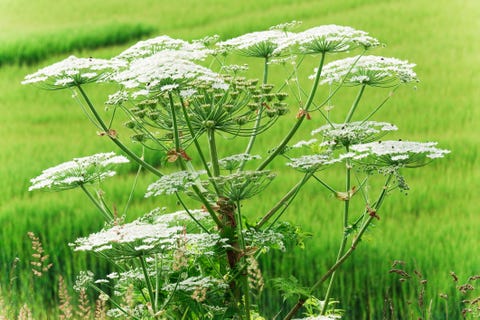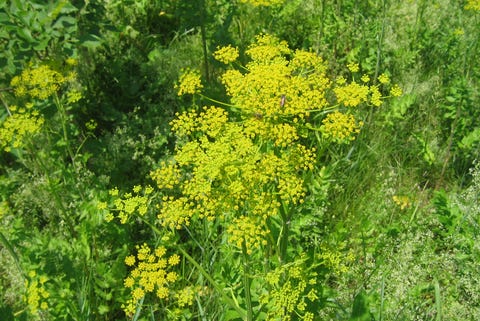National Home Gardening Club Complaints
What's 14 feet tall, green, hairy, and covered in toxic sap? It may sound like a monster, but this scary beast is actually giant hogweed, a towering, invasive plant whose sap can cause painful burns, scarring, and possibly even blindness.
Originally from the the Caucasus mountain region of Eurasia, researchers just confirmed the presence of this federally listed "noxious weed" in Virginia for the first time. The state now joins Maine, Massachusetts, Vermont, Connecticut, New York, Pennsylvania, North Carolina, Michigan, Illinois, Washington, and Oregon as hosts to this non-native plant.
Naturalists intentionally brought the species here in the early 1900s, as its size and enormous flowers made it desirable for ornamental planting. However, the average giant hogweed produces a whopping 20,000 seeds that can fall 30 feet from the plant and travel even farther through wind or water. Translation: It didn't take long for this species to spread out of control — and start injuring unsuspecting gardeners.

Juliette Wade Getty Images
Why Giant Hogweed Is Dangerous
The danger of giant hogweed stems from its sap, which is present on all parts of the plant. Toxic chemicals in it called furanocoumarins cause severe burns when exposed to UV light from the sun. Even when the painful blisters subside, permanent scarring can remain.
"The more sap you touch, the greater damage it causes," Naja Kraus, the New York Department of Environmental Conservation's Giant Hogweed Program Coordinator, tells GoodHousekeeping.com. "Once you get it on you, it makes your skin unable to protect itself from the sun."
The reaction — called phytophotodermatitis — is similar to how some antibiotics you take make your skin more sensitive to UV light. "It basically fuses your DNA in that area," Kraus explains.
One 17-year-old boy recently went to the hospital with second- and third-degree burns after he accidentally chopped down a giant hogweed plant as part of his summer landscaping job. Alex Childress of Spotsylvania County, Virginia, didn't notice anything unusual until he went to take a shower that evening.
This content is imported from Facebook. You may be able to find the same content in another format, or you may be able to find more information, at their web site.
"I started rubbing my face," he told People. "I thought it was just a little bit of skin at first, but then big chunks of my face were falling off." Childress stayed in the Virginia Commonwealth University's burn center for two days, and now must avoid the sun for up to six months.
While other news reports warn of blindness as another side effect, Kraus says she hasn't encountered a verified case in her 11 years with the Giant Hogweed Program, but their hotline has received more than enough calls reporting the painful burns.
How to Identify Giant Hogweed
If you encounter a plant that resembles giant hogweed in your backyard, the first step is to verify it. Giant hogweed doesn't grow to 14 feet overnight; the seedlings and saplings start out much smaller. It's only after three to five years — when the plant gains enough energy from its roots — that it rockets in growth and begins to produce early-summer white flowers one to two feet across, as well as five-foot-wide lobed, jagged leaves.
Anything with smaller blooms (like Queen Anne's lace) is probably an imposter. Two other similar looking species include the very benign native plant cow parsnip, which only grows to about six feet, and Angelica, which has compound leaves and smooth stems.

Getty Images
The easiest way to identify giant hogweed is to look for purple blotches and white hairs on the stem. If the plant has both those qualities, there's a strong chance it's the real thing. Keep an eye out in open sites with lots of light and moist soil, as well as partially shaded areas along streams, rivers, and roads as well as in fields, forests, and yards.
This content is imported from {embed-name}. You may be able to find the same content in another format, or you may be able to find more information, at their web site.
You should also watch out for wild parsnip. It's in the same family and produces the same toxic sap, but doesn't grow as tall. Look for yellow flowers and grooved stems.

Naja Kraus
What to Do If You See It
The first step is report it to your local authority, like the Department of Environmental Conservation or an extension service.
The agency may remove it or advise you on how to do it yourself safely wearing protective gear. Experts may recommend manual methods of control — like cutting the roots — or applying an herbicide. In addition to posing a public health risk, this species poses an ecological hazard as well by reducing plant diversity and causing soil erosion, Kraus says.
What to Do If the Sap Gets on Your Skin
If you inadvertently brush up against any part of giant hogweed, you might notice the skin reaction within 15 minutes. Dark, painful blisters will form within two days, and the purplish or brown scars and sensitivity to sunlight can last for years.
This content is imported from Facebook. You may be able to find the same content in another format, or you may be able to find more information, at their web site.
To minimize the damage, immediately wash the affected area with soap and water and contact your physician ASAP if you experience a reaction. A GP may prescribe topical or oral steroids to reduce the severity and help it heal faster. Cover your skin to protect it from sunlight for the next few days.
"When it's blistered, just wearing a long-sleeve shirt isn't enough," Kraus says. "You actually have to wrap it with an ace bandage or wear sun-protective clothing. You can't get any UV rays on it at all." You'll want to protect the burned area from sunlight for the next few years as well to reduce scarring.
While these side effects certainly sound scary, avoiding them is as easy as learning to identify this species — and steering clear when you see it. "People are often very frightened when they hear about giant hogweed," Kraus says. "It's really important to realize that it's a plant. It can't move. The only way you can burned by giant hogweed is to touch it."
Caroline Picard Health Editor Caroline is the Health Editor at GoodHousekeeping.com covering nutrition, fitness, wellness, and other lifestyle news.
This content is created and maintained by a third party, and imported onto this page to help users provide their email addresses. You may be able to find more information about this and similar content at piano.io
National Home Gardening Club Complaints
Source: https://www.goodhousekeeping.com/home/gardening/a21598753/giant-hogweed/
Posted by: vaughtthastenthe.blogspot.com

0 Response to "National Home Gardening Club Complaints"
Post a Comment